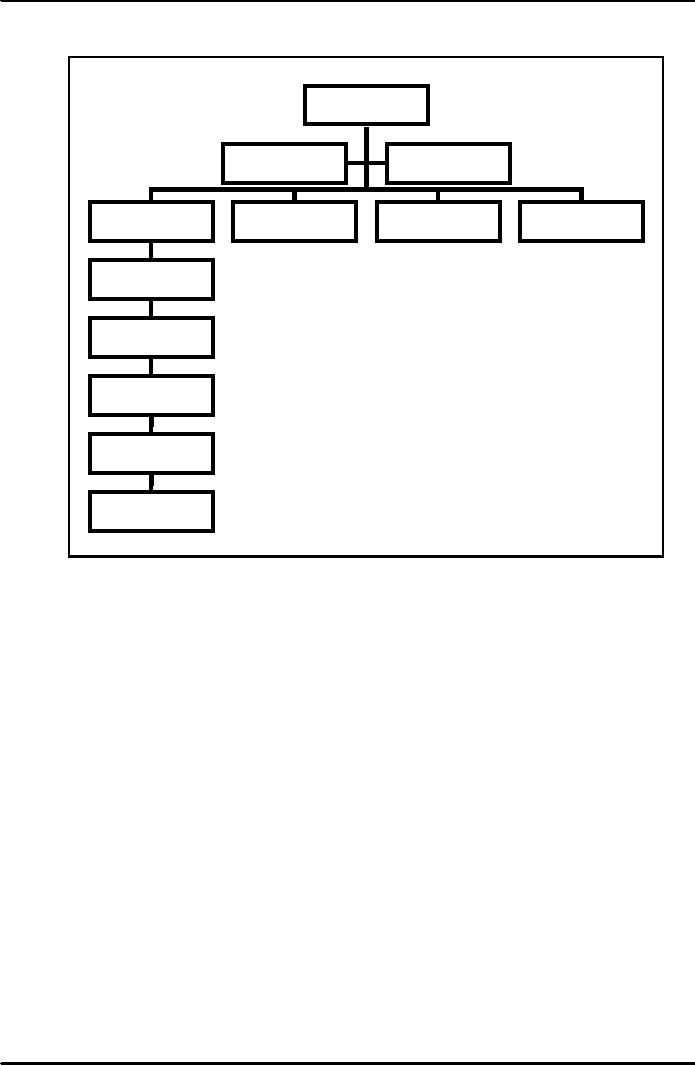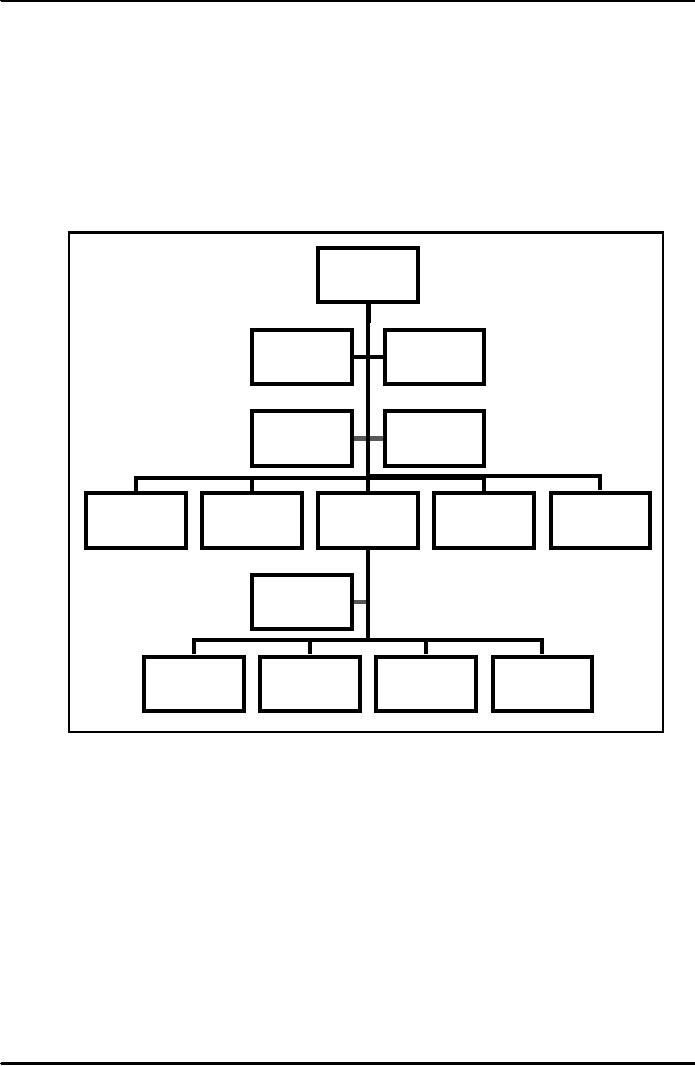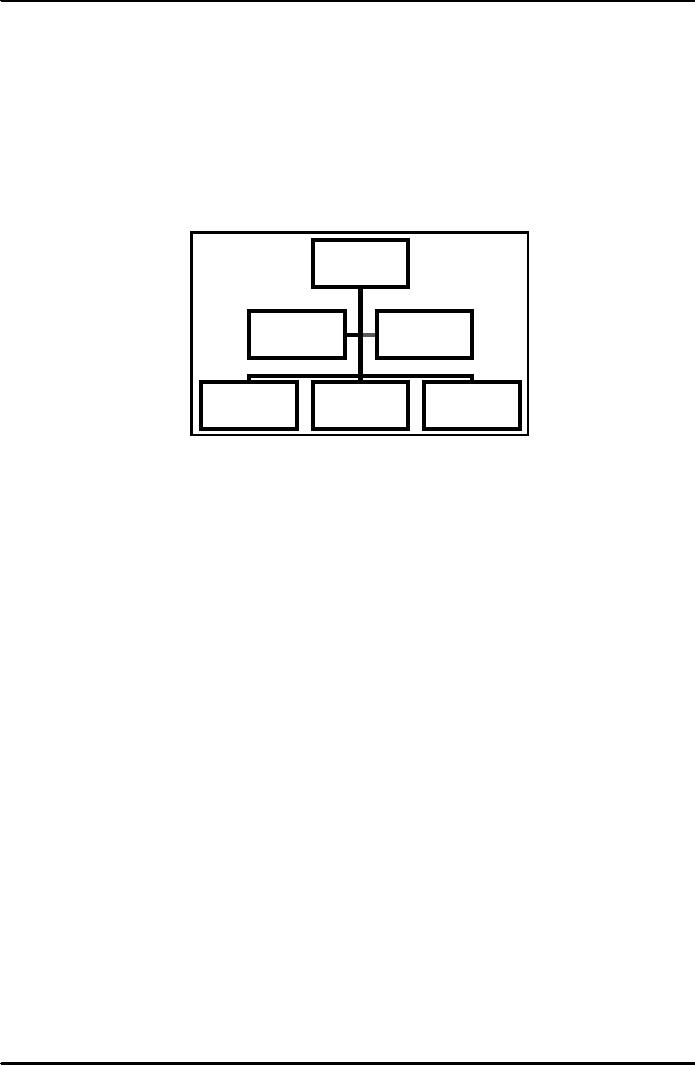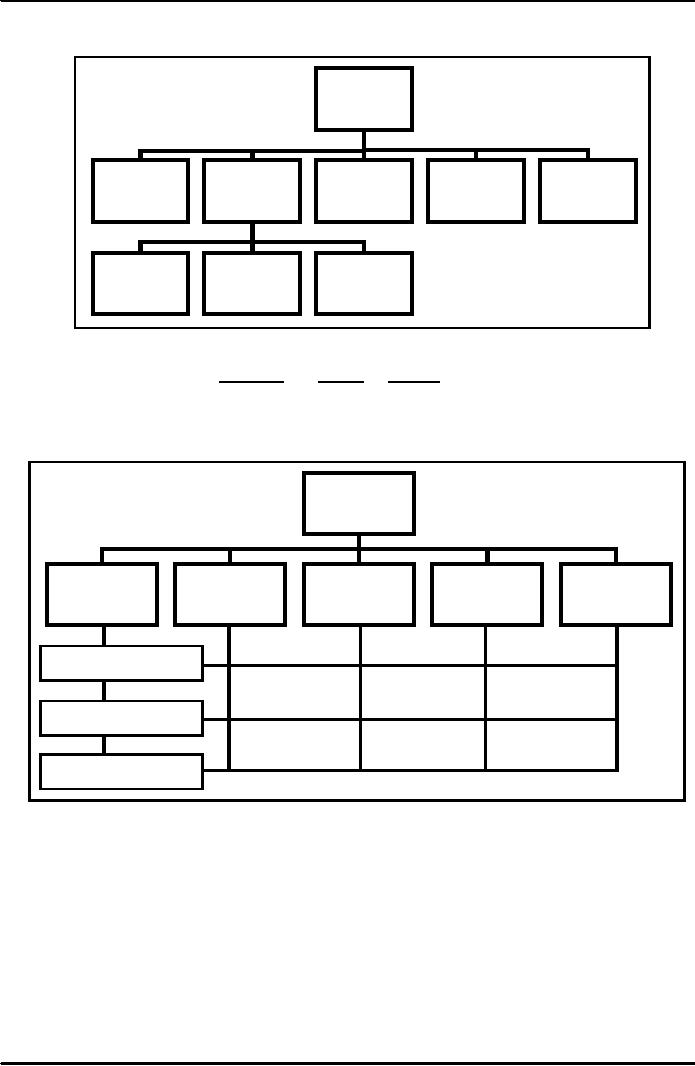 |

Introduction
To Public
AdministrationMGT111
VU
LESSON
15
DEPARTMENTALIZATION
At the
end of the lecture the students should be
able to understand:
·
What
is Department
·
What
are the Basis of
Departmentalization
·
Advantages
and Disadvantages of various
types of Departmentalization
·
The
Concept of Authority and
Decentralization
Department
Let
us go back to the definition of
department.
"A
department is a distinct area, division,
or branch of organization over which
manager has
authority
for performance of specified
activities"
When
activities and tasks are grouped
according to some basis of
similarity, it is called
departmentalization.
Departmentalization
by simple numbers
Departmentalization
by number is done by putting people in group
who are to perform the
same
duties.
They are placed under supervision of a
manager or supervisors. Example: Armies in
old times,
Unskilled
labour in construction.
Departmentalization
by time
Departmentalization
by time is done at operational or lower levels of
organizations where activities
are
grouped together on the basis of time. Example: People
working in shifts in steel
company, hospitals
etc.
Advantages
Departmentalization
by time has two main
advantages; These
are:
1.
The
usual timings of offices are eight hours,
but if departmentalization is to be done
beyond
8 hours, second shift or
round the clock service can be
provided.
2.
Equipment
can be used more often in
shifts: The tools, equipment and
physical facilities
can
be used to full
capacity.
Disadvantages
1.
Lack
of supervision: People working in
shifts may not be
supervised.
2.
Increase
of overtime rates: There may be increase
in expenditure due to payment to
workers
in shift.
Departmentalization
by Enterprise Function
Departmentalization
by function is the grouping of the
activities in accordance with the
functions
of
the enterprise (Functional Departmentalization).
Example of functions of organization:
Production,
Budgeting,
Accounts, Sales etc.
53

Introduction
To Public
AdministrationMGT111
VU
Departmentalization
by Enterprise Function
Figure
- 1
President
Assistant
to
Personnel
Officer
President
Marketing
Engineering
Production
Finance
Department
Department
Department
Department
Marketing
Research
Marketing
Planning
Advertising
and
Promotion
Sales
Administration
Sales
In
figure 1 is the organization chart (also
called organogram) of a private
company. The
functional
departmentalization
of a company is shown. There are 4
functional departments i.e. marketing,
engineering,
production
and finance. Under the marketing
department all market related activities
are grouped i.e.
marketing
research, marketing planning, advertising
and promotion, sales and
administration.
Departmentalization
by function is the most common form of
departmentalization.
Advantages
of Departmentalization by
Function
Following
are the advantages of departmentalization by
function:
1.
It
is logical reflection of functions: This is
more common and logical way of
grouping
activities.
2.
Maintains
power of major functions: Certain functions in organization
are more important
as
the main or core area. For
example in universities the academic
department will be major
function.
3.
Simplifies
training: Since people are grouped
according to functional departmentalization,
it
becomes
easier to provide training to
employees in a particular functional area
wise.
4.
Tight
control on the top: Each department
head can exercise control
over its own
functional
area.
Disadvantages
of Departmentalization by
Function
Following
are disadvantages of departmentalization by
functions:
1.
Reduces
coordination among functions: Since
employees work in respective
department;
therefore,
coordination amongst various department
is reduced.
2.
Slow
adaptation to changing environment: When
people work for longtime in a
department
they
become use to with the
working and their styles
become rigid. For example a
police
54

Introduction
To Public
AdministrationMGT111
VU
officer
style of working would be
different from that of a
teacher. Therefore, they are slow
to
changing
environment.
3.
Limits
development of managers: Development of
mangers is limited to a particular
function
only.
Departmentalization
by Geography
Activities
of an organization in a given area or territory
are grouped and assigned to a
manager.
Example:
Electricity and gas is supplied by
regional organizations, such as local
electricity Supply
Corporation,
Sui Northern Gas Company
and Sui Southern Gas
Company.
Departmentalization
by Geography
Figure-2
President
Marketing
Personnel
Purchasing
Finance
Western
Southwestern
Central
Southeastern
Eastern
Region
Region
Region
Region
Region
Personnel
Engineering
Production
Accounting
Sales
Figure
2 is the organization chart of an organization that
has centralized marketing,
personnel,
purchasing
and finance. Under the
central region are shown
personnel engineering, production,
accounting
and
sales, and likewise these
functions also exist for
other four geographical
regions.
Advantages
Following
are the advantages of departmentalization on the
basis of geography:
1.
Emphasis
on local market: The local
markets can gain benefit as
service is provided
according
to geography. It helps develop that
market.
2.
Improves
coordination: Coordination within the
geographical unit is better because
all
functional
departments operate at the geographic
region.
3.
Face-to-face
communication: There is better communication between the
service
provider
and service receiver.
Disadvantages
Following
are the disadvantages of departmentalization by the
geography:
55

Introduction
To Public
AdministrationMGT111
VU
1.
Problems
of control: As the functions are
dispersed, therefore control cannot
be
exercised
effectively
2.
Requires
more human capital: from the
above it is deduced that
more people are
required.
3.
Makes
maintenance more difficult: Maintenance
of service become
difficult.
Customer
Departmentalization
It
is grouping of activities so that these
reflect primary interest of the customers in a variety
of
enterprises.
Customer
Departmentalization
Figure-3
President
Community-
Corporate
City
Banking
Banking
Instructional
Real
Estate
Agricultural
Banking
Loans
Banking
Customer
departmentalization is usually found in
banking sector but there
could be other
organizations
that may have customer
departmentalization. In figure-3 customer departmentalization
is
shown.
In the figure the bank has grouped
banking activities according to the types
of loans that will be
acquired
by specific type of customer e.g.,
agricultural banking department will
provide loans to
farmers.
Real
estate loans will be
provided to customers who plan to
buy property. Institutional
banking will deal
with
institutional customers.
Advantages
1.
Encourages concentration on customer
needs
2.
The focus is on customer
satisfaction
3.
The staff develops expertise in
customer area.
Disadvantages
1.
Since everybody works in respective area
coordination becomes
difficult
2.
There is underutilization of facilities and
labour-specialized workers in customer
groups
Departments
by Product
Grouping
of activities on the basis of the
products or the product lines of an
organization is known
as
departmentalization by production or product.
Some times organization may be
producing more than
one
product or services. For
example a firm may be
producing soaps, detergents, toothpaste
etc. So for each
product
it would have separate
department. In the organization chart in
figure 4 the organization has
three
separate
services like punch-press, welding
and electroplating.
56

Introduction
To Public
AdministrationMGT111
VU
Department
by Production
Figure
4
President
Engineering
Production
Marketing
Finance
Personnel
Punch
-
Welding
Electroplating
Presses
Matrix
Organizations
It
is the combination of functional and
project or product patterns of
departmentalization in the
same
organization structure
Matrix
Organization
Figure
5
Director
Preliminary
Mechanical
Electrical
Hydraulic
Metallurgical
Design
Chief
Engineer
Chief
Engineer
Chief
Engineer
Chief
Engineer
Chief
Project
`A' Manager
Project
`B' Manager
Project
`C' Manager
As
shown in the figure 5 which
shows matrix organization in engineering
department, there are
functional
managers in charge of engineering
functions and an overlap of project
managers responsible
for
the
end product. This form of organization is
common in research and engineering
organization it has been
used
in product marketing organizations as
well.
PROBLEMS
WITH MATRIX MANAGEMENT
Let
us summarize some typical problems in
matrix structure. These
are:
1.
A state of conflict exists
between functional and
product managers as both
compete for limited
sources
(for example financial and
human).
2.
There is conflict of roles and ambiguity
because there is overlap of
functions.
3.
There is imbalance of authority and power
as well as horizontal and vertical
influence of the project
and
functional managers which
can lead to problem in
matrix organization.
57

Introduction
To Public
AdministrationMGT111
VU
4.
Because of potential conflict,
managers may want to protect
themselves against blames by
putting
everything
in writing which increases administrative
cost.
5.
Matrix organization require many time
consuming meetings
Concepts
Departmentalization:
grouping
of activities according to some
specific
activities
over which manager has
authority
Departmentalization
by function:
grouping
of activities by functions
Departmentalization
by geography:
Activities
of an organization in a given area or
territory
are grouped and assigned to a
manager
Departmentalization
by customer:
It
is grouping of activities so that these
reflect
primary
interest of the customers.
Matrix
organizations:
It
is the combination of functional and
project or
product
patterns.
58
Table of Contents:
- INTRODUCTION:Institutions of State, Individualism
- EVOLUTION OF PUBLIC ADMINISTRATION:Classical School, The Shovelling Experiment
- CLASSICAL SCHOOL OF THOUGHTS – I:Theory of Bureaucracy, Human Relation Approach
- CLASSICAL SCHOOL OF THOUGHTS – II:Contributors of This Approach
- HUMAN RELATIONS SCHOOLS:Behavioural School, System Schools
- POWER AND POLITICS:Conflict- as Positive and Negative, Reactions of Managers, Three Dimensional Typology
- HISTORY OF PUBLIC ADMINISTRATION – I:Moghul Period, British Period
- HISTORY OF PUBLIC ADMINISTRATION – II
- CIVIL SERVICE:What are the Functions Performed by the Government?
- CIVIL SERVICE REFORMS:Implementation of the Reforms, Categories of the Civil Service
- 1973 CONSTITUTION OF PAKISTAN:The Republic of Pakistan, Definition of the State
- STRUCTURE OF GOVERNMENT:Rules of Business, Conclusion
- PUBLIC AND PRIVATE ADMINISTRATION:The Public Interest, Ambiguity, Less Efficient
- ORGANIZATION:Formal Organizations, Departmentalization
- DEPARTMENTALIZATION:Departmentalization by Enterprise Function, Departments by Product
- POWER AND AUTHORITY:Nature of Relationship, Delegation of Functional Authority
- DELEGATION OF AUTHORITY:The Art of Delegation, Coordination
- PLANNING – I:Four Major Aspects of Planning, Types of Plans
- PLANNING – II:Planning ProcessThree principles of plans
- PLANNING COMMISSION AND PLANNING DEVELOPMENT:Functions, Approval Authority
- DECISION MAKING:Theories on Decision Making, Steps in Rational Decision Making
- HUMAN RESOURCE MANAGEMENT (HRM):Importance of Human Resource, Recruitment
- SELECTION PROCESS AND TRAINING:Levels at Which Selection takes Place, Training and Development
- PERFORMANCE APPRAISAL:Formal Appraisals, Informal Appraisals
- SELECTION AND TRAINING AND PUBLIC ORGANIZATIONS:Performance Evaluation,
- PUBLIC FINANCE:Background, Components of Public Finance, Dissimilarities
- BUDGET:Components of Public Income, Use of Taxes, Types of Taxation
- PUBLIC BUDGET:Incremental Budget, Annual Budget Statement, Budget Preparation
- NATIONAL FINANCE COMMISSION:Fiscal Federalism Defined, Multiple Criteria
- ADMINISTRATIVE CONTROL:Types of Accountability, Internal Control, External Control
- AUDIT:Economy, Effectiveness, Objectives of Performance Audit, Concepts
- MOTIVATION:Assumptions about Motivation, Early ViewsThree Needs
- MOTIVATION AND LEADERSHIP:Reinforcement Theory, Leadership, The Trait Approach
- LEADERSHIP:Contingency Approaches, Personal Characteristics of Employees
- TEAM – I:Formal & Informal teams, Functions of Informal Groups, Characteristics of Teams
- TEAM – II:Team Cohesiveness, Four ways to Cohesiveness, Communication
- COMMUNICATION – I:Types of Communication, How to Improve Communication
- COMMUNICATION – II:Factors in Organizational Communication, Negotiating To Manage Conflicts
- DISTRICT ADMINISTRATION:The British Period, After Independence, The Issues
- DEVOLUTION PLAN – I:Country Information, Tiers or Level of Government
- DEVOLUTION PLAN – II:Aim of Devolution Plan, Administrative Reforms, Separation of powers
- POLITICAL REFORMS:District, Tehsil, Functions of Union Council, Fiscal Reforms
- NEW PUBLIC MANAGEMENT (NPM):Strategy, Beginning of Management Approach
- MANAGERIAL PROGRAMME AGENDA – I
- MANAGERIAL PROGRAMME AGENDA – II:Theoretical Bases of Management, Critique on Management